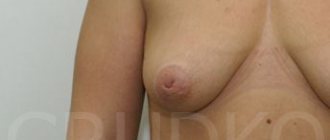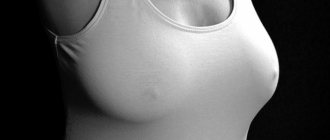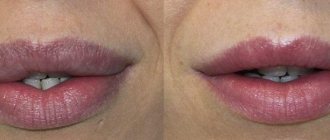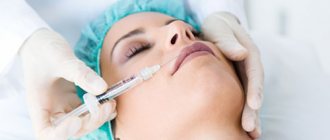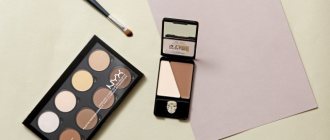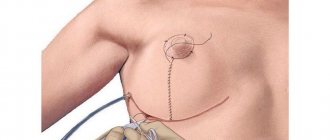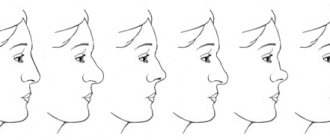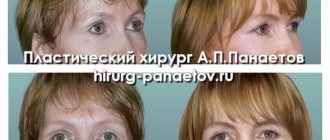What affects the shape of the nipples
The condition of the breasts, including nipples, is affected by various factors throughout life, which in one way or another affect their shape, size and position.
Most of them are associated with hormonal processes during puberty, pregnancy, childbirth, and breastfeeding. Congenital anomalies are quite rare, but age-related skin changes and sudden weight fluctuations have a strong effect on appearance. Also, the causes of changes can be injuries or operations for diseases of the mammary glands. Of course, changes in the nipples do not affect a woman’s health, but they often cause psychological discomfort, low self-esteem, and rejection of close relationships, which can seriously worsen the quality of life. And such a problem as inverted nipples sometimes jeopardizes the possibility of breastfeeding.
Small-scale operations to correct the nipple-areolar complex do not require long-term rehabilitation and can solve practically any issues related to the deformation of this delicate area. The results of such interventions usually last for life, if repeated breast surgery and other changes are not expected.
RECONSTRUCTION OF THE NIPLE-AREOLAR COMPLEX
The cost of the procedure is from 19,000 ₽.
The aesthetics of the breast is not only a round, regular shape and proportionate fullness, but also the neatness and proportionality of the areolas.
Nipples that are too large, too small, asymmetrical, inverted, deformed or too pigmented can cause a woman to develop serious complexes regarding her own appearance. Correction of the nipple-areolar complex allows you to surgically eliminate areola defects and improve the condition of the periareolar area, get rid of congenital defects and restore self-confidence. Indications:
- disproportionate nipples (too big, too small);
- pronounced asymmetry of the areolas;
- flattening or retraction of the nipples;
- pronounced disproportion of areolas and nipples;
- disproportionate volume of nipples;
- absence of nipples (after mastectomy or as a congenital anomaly);
- cicatricial deformation of the nipples (after surgery, injury, etc.).
Contraindications:
- the time of breastfeeding and at least another six months after the end of lactation;
- decompensated diabetes mellitus;
- oncological diseases of any localization;
- exacerbation of chronic diseases, failure of liver and kidney function;
- acute diseases of the body, including infectious ones;
- a number of benign changes in the mammary glands, such as large or multiple cysts, seals;
- blood clotting disorder;
- tendency to develop hypertrophic and keloid scars.
Operation duration: 1 hour
Anesthesia: local
Stages of implementation:
The most popular methods of correction of the periareolar region
- Reduction or tightening of the areola. Using pre-made markings at the border of the isola, excess skin is excised, an areola of the desired size and shape is formed, and then fixed in the desired position. The nipple does not lose sensitivity, breastfeeding subsequently proceeds without problems.
- Nipple reduction. The operation involves excision of a section of the nipple followed by the application of a cosmetic suture. There may be a temporary loss of sensation after surgery, and breastfeeding is usually difficult.
- Correction of inverted nipples. The standard correction involves making an incision at the base of the nipple and fixing it in the desired position. The time for complete healing after this procedure is about 2-3 weeks. The nipple does not lose sensitivity after the operation, but it is better to perform the correction after the end of the childbearing period.
- Restoration (reconstruction) of the nipples. This operation usually involves nipple plastic surgery using local tissue (breast tissue) in combination with tattooing to reproduce the natural shape of the areola. The recovery procedure can reduce psychological discomfort in patients who have undergone a mastectomy - removal of the breast after a cancer diagnosis.
Primary rehabilitation (sutures, swelling, hospital)
- Wearing compression garments: 1 month
- Removal of sutures: 10-14 days
- Swelling: several weeks
- Compression garment: bra
Limitations of the rehabilitation period
- For a month after surgery, any strength training is prohibited.
- Visits to saunas, baths, swimming pools are limited for 2-3 weeks
- DO NOT sleep on your stomach for a month after surgery. You can lie on your side 2 weeks after the intervention
- Avoid lifting heavy objects for a month after surgery
When should you seek help from a plastic surgeon?
Nipple plastic surgery or correction is indicated in situations such as an inverted or overly stretched nipple, a disproportionately wide or long nipple, an overly large areola (pigmented area near the nipple), an asymmetrical location or shape, deformation or complete absence of the nipple.
During the examination, the specialist will determine whether you have indications for surgical nipple correction and will select the optimal solution. If the situation can be corrected using a non-surgical method, then he will definitely tell you about it. The main thing is that you trust the doctor you choose.
Operation technique
Nipple and areola correction can be performed under local anesthesia or general anesthesia. The duration of the operation depends on the specific case, on average it is about an hour. The surgeon's tactics are determined by the problem at hand. For example, if an inverted nipple repair is performed , the surgeon cuts the connective tissue that holds the nipple in an inverted position. This requires a microscope, because it is impossible to see thin fibrous threads with the naked eye. This intervention does not affect the milk ducts, which means that the ability to breastfeed remains.
Another example is large nipple areolas . In this case, two circular cuts are made. The first is at the border of the areola and the skin, the second corresponds to the new size of the areola. The area of tissue between the two incisions is removed and stitches are placed.
Correction of the areola and nipple is perfectly combined with operations such as breast lift, breast reduction, and breast replacement.
Nipple plastic surgery in men
Men also turn to specialists for nipple surgery. The reasons for surgery may be injuries or congenital pathologies when the nipple is missing or severely damaged. There are also those who simply want to be perfect in everything, or regularly demonstrate themselves, for example, at bodybuilding competitions. Then a plastic surgeon is asked to reduce the nipples or make them symmetrical.
If a man decides to undergo surgery due to gynecomastia, then most often the changes will affect the nipple-areolar complex. Nipple reduction and repositioning may also be necessary for those who have lost weight.
Rehabilitation after nipple and areola reduction
In the first few days after surgery, there may be a slight burning sensation in the area of the nipple-areolar complex. The patient can optionally take an analgesic that suits him. Sutures are removed 7-10 days after nipple and areola reduction surgery. During the recovery period (about two weeks), it is recommended to wear a soft bra: this will help avoid unnecessary pressure on the operated area and reduce irritation. Temporary loss of nipple sensitivity is possible. Nipple reduction (before and after surgery) is clearly shown in the photo: the result six months after the operation.
The price for nipple and areola reduction (the entire nipple-areolar complex) in our clinic is 40,000 - 45,000 rubles. Local anesthesia is not included in the cost of the operation and is paid additionally (5000 rubles). The average price for areola and nipple reduction in Moscow is 55,00 rubles.
Cost of areola and nipple correction
| Name | Price |
| Primary appointment (examination, consultation) with a plastic surgeon | FOR FREE |
| Surgical correction of breast areolas (retracted, asymmetrical) two sides, category 1 | 40,000 rub. |
| Surgical correction of breast areolas (retracted, asymmetrical) two sides, category 2 | 45,000 rub. |
| Surgical correction of the areolas of the mammary glands (on one side) category 1 | 20,000 rub. |
| Surgical correction of the areolas of the mammary glands (on one side) category 2 | 25,000 rub. |
Preoperative preparation
During the initial consultation, the doctor conducts an examination, determines the indications for surgical intervention and its scope. A thorough survey helps to identify the reasons for the current situation in order to select the optimal plastic surgery option.
It is also necessary to exclude contraindications, including age under 18 years, severe chronic diseases, blood clotting disorders, a tendency to form keloid scars, neoplasms, acute infections or exacerbations of chronic ones, pregnancy, and breastfeeding.
Be sure to tell your doctor if you have allergic reactions to any medications, what medications you take regularly, and what illness you have had in the last few weeks.
To assess your health and make sure that the operation will not harm you, you will be prescribed an additional examination. It usually includes laboratory tests (general detailed blood and urine analysis, biochemical analysis, coagulation tests, HIV, syphilis, hepatitis) and instrumental studies (mammography, ultrasound of the mammary glands, electrocardiography). If necessary, this list is expanded. It is convenient if the plastic surgery department is part of a large clinic. Then all studies can be completed in one place, and tests can be performed in your own laboratory, which is trusted by doctors.
If the examination is successful, the day of surgery is set. They will definitely tell you how the operation will take place, what it involves and how to prepare. Most often, it is recommended to stop taking hormonal medications, including contraceptives, and blood thinners, such as aspirin, 2 weeks before the correction. It is also advisable to give up bad habits - smoking, alcohol - at least for a while. On the day of surgery you should not eat or drink.
Contraindications
Our surgeons conduct a comprehensive examination of patients before surgery. Mammoplasty and nipple correction are not performed if the following contraindications are present:
- Blood clotting disorders;
- Infectious diseases;
- Viral respiratory infections, including COVID-19;
- Malignant tumors;
- Diabetes mellitus.
We do not perform areola and nipple correction for pregnant and breastfeeding women and persons under eighteen years of age.
How is nipple plastic surgery performed?
Depending on the volume, the operation is performed under local or general anesthesia. If this is only nipple plastic surgery, it lasts from 1 to 2 hours.
In order to correct an inverted nipple, milk ducts are released, which not only corrects an aesthetic defect, but also restores the possibility of breastfeeding. For such an intervention, microsurgical methods are used, so recovery is quite fast.
If it is necessary to reduce the size of the nipple, then wedge-shaped excision is performed. This often makes further breastfeeding difficult. But this problem is usually addressed by women for whom this period has already ended, and such intervention will not harm them.
When it is necessary to transfer the nipple and areola in connection with breast shape correction, the entire complex is excised and moved to a new location.
To correct the areola, they usually simply reduce its size and correct the asymmetry.
Nipple restoration operations are considered the most difficult. It has to be formed from skin, and a pigmented area of skin for the areola is either transplanted from another area (perineum), or tattooing techniques are used.
Any operation must be carried out under conditions of complete sterility, in compliance with all rules of asepsis and antiseptics.
Indications and contraindications for nipple correction
Correction of inverted nipples and altered areolas is performed at the request of the patient. There are no strict medical indications for the operation. Most often, patients turn to a surgeon in the following cases:
- Asymmetry of the nipple-areolar complex.
- Aesthetic defects resulting from trauma.
- Uneven contour.
- Inverted or excessively protruding nipples.
- Nipple restoration after piercing.
- Large nipple areolas.
To undergo surgery, you must have a certain health condition. Contraindications to surgery are:
- Pregnancy and breastfeeding.
- Some infectious diseases.
- Severe diseases of internal organs.
- Endocrine disorders.
- Malignant tumors.
- Mental disorders.
The surgeon may refuse to perform an operation for other types of pathology that may pose a threat to health.
Postoperative period
If the operation was performed under local anesthesia, you may be allowed to go home on the same day or the next. If it is general, they will offer to stay under observation a little longer.
Dressings are done every day until the stitches are removed, which usually happens on days 7-10. Additionally, you need to wear special compression garments for 2 weeks to a month. In the early postoperative period, slight swelling and hematomas are possible, which disappear on their own during the first week.
In order not to provoke deterioration, thermal procedures (sauna, steam bath), direct sunlight, including solariums are not recommended. During the first month, avoid heavy physical activity and drinking alcohol.
If you experience signs of inflammation (redness, new swelling, pain) in the surgical area, contact your doctor immediately. Timely assistance will prevent the development of serious complications.
If you doubt whether you need nipple plastic surgery, whether correction is needed and what kind, come for a consultation with an experienced surgeon and ask all the questions. Stay beautiful and confident!
Rehabilitation
Swelling and bruising are constant companions of any plastic surgery. There is no need to worry in this situation; these temporary complications go away on their own in 7-10 days. In addition, you must follow some doctor's recommendations:
- Avoid visiting the sauna, solarium, and swimming pool.
- Wear special supportive underwear for some time.
- Limit physical activity.
- Sleep on your back or side.
In general, the rehabilitation period is short - only 2-3 weeks.
Despite the simplicity of the operation, you should not trust it to a beginner. Even the most harmless technique in the hands of an amateur can seriously affect the patient’s health. Only a certified specialist with extensive experience in performing such interventions can guarantee the declared result with minimal risks and complications.
